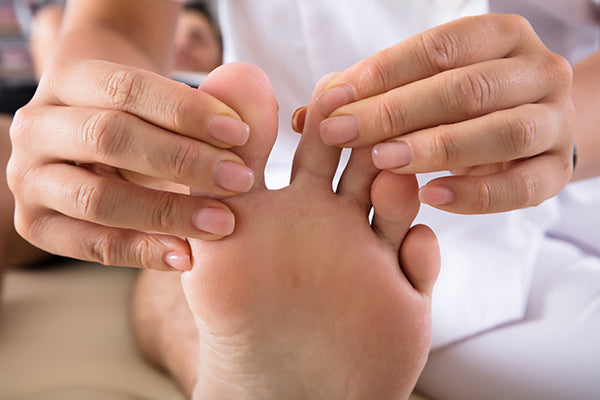
Hammertoe and Foot Pain
A hammertoe is when the foot is deformed along the second, third or the fourth toe. The deformity occurs when the toe becomes crooked and bent in the center joint which causes it to resemble a hammer in shape. Hammertoes are still flexible in the beginning stages of the deformity, and they can often be fixed with quite simple treatment procedures when handled early. If the hammertoe goes untreated, the toes can become immobile and fixed which usually results in your needing surgery.
What Signs Are Indicative of a Hammertoe?
 Those who suffer from hammertoes are often going to have calluses and corns on the top of the central joint in the toe. These can also be found on the tip of the toe. Pain in the foot and toes could also be a telltale sign, and finding shoes that fit comfortably may become difficult. Hammertoe is caused most commonly by a muscular imbalance or from repeatedly wearing shoes that do not fit. Oftentimes, they happen due to a combination of both. Since muscles work in twos in order to bend and straighten the toes, if the toe becomes held in one spot or bent long enough, the muscles will become too tight to ever stretch out naturally again without medical help.
Those who suffer from hammertoes are often going to have calluses and corns on the top of the central joint in the toe. These can also be found on the tip of the toe. Pain in the foot and toes could also be a telltale sign, and finding shoes that fit comfortably may become difficult. Hammertoe is caused most commonly by a muscular imbalance or from repeatedly wearing shoes that do not fit. Oftentimes, they happen due to a combination of both. Since muscles work in twos in order to bend and straighten the toes, if the toe becomes held in one spot or bent long enough, the muscles will become too tight to ever stretch out naturally again without medical help.Shoes that tend to get narrower near the toes are able to make your forefoot appear smaller, but because they are pushing your toes into a bent position, it is not worth the aesthetic benefits. The toes can rub on the shoe which causes calluses and corns to form. When they do, it only makes the hammertoe worse. With high heels, the foot is forced down and it pushes the toes against the shoe itself, which amplifies the pressure on the toes and the amount that it is bending. Soon enough, the muscles in the toes will not be able to straighten out again, regardless of whether or not you are wearing a comfortable shoe.
Treatment for Hammertoe
There are some treatments you can begin at home when you first notice signs of hammertoe. You can do simple things such as finding new shoes with a roomier toe box. You can get shoes that have a softer upper that won't irritate the skin. This means avoiding narrow shoes like high heels. Finding a shoe repair store may allow you the chance to have your shoes professionally stretched to make them more accommodating to your condition.
 Your doctor may show you some toe exercises that can help to strengthen the muscles of the toes while stretching them back out. An example of a stretch you might be asked to perform includes manually stretching the toes using your hands. This is where foot alignment socks shine. They provide a gentle stretch to the toes for an extended period of time. Socks that align the toes work to reverse the squeezing pressure that high heels or tight shoes create. There are a couple of simple exercises that can help your toes. First, using your toes to grab and pick up things off of the floor. Secondly. as you sit on a sofa to read or watch television, you can lay a flat towel under your feet and crumple it up with your toes.
Your doctor may show you some toe exercises that can help to strengthen the muscles of the toes while stretching them back out. An example of a stretch you might be asked to perform includes manually stretching the toes using your hands. This is where foot alignment socks shine. They provide a gentle stretch to the toes for an extended period of time. Socks that align the toes work to reverse the squeezing pressure that high heels or tight shoes create. There are a couple of simple exercises that can help your toes. First, using your toes to grab and pick up things off of the floor. Secondly. as you sit on a sofa to read or watch television, you can lay a flat towel under your feet and crumple it up with your toes.When to Consider Surgery
Surgery is a final option for treating hammertoes. This can be done if the more conservative and holistic methods do not work. Surgery is often done with a local anesthetic as an outpatient. The procedure will depend on how extreme the deformity is. This procedure will leave you feeling swollen, stiff and red more likely than not. You will be able to get up and move around, excessive walking is discouraged until the toe fully heals.
Unfortunately, surgery does not mean that the hammer toe will never come back. If it does happen, surgery may be needed again to get rid of the pain.
* "Foot Alignment Socks" are not a substitution for medical treatment. For serious foot problems, see your Physician or Podiatrist
Share this post
- Tags: foot pain relief, hammertoe